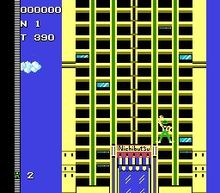- Crazy Climber
-
Crazy Climber 
Promotional flyer, showcasing the arcade cabinets used for the titleDeveloper(s) Nichibutsu Publisher(s) Nichibutsu
Taito America Corporation (US)Designer(s) Shigeki Fujiwara Platform(s) Arcade, Arcadia 2001, Atari 2600, FC, WonderSwan, Virtual Console Release date(s) 1980
Virtual Console
- JP February 23, 2010
Genre(s) Platform Mode(s) Up to 2 players, alternating turns Cabinet Upright Display Raster, standard resolution Crazy Climber (クレイジークライマー) is a coin-operated arcade game produced by Nichibutsu in 1980. It was also released in North America by Taito America Corporation by UA Ltd. in 1982 for the Emerson Arcadia 2001 and other video game consoles. It is one of Nichibutsu's most highly-acclaimed video games in its library. A precursor to the platform game genre, Crazy Climber was the first game revolving around climbing, specifically climbing buildings, before Nintendo's 1981 release Donkey Kong.[1][2]
Contents
Description
In Crazy Climber the player assumes the role of a daredevil who is attempting to climb to the top of four skyscrapers. There are a number of obstacles and dangers to avoid including:
- Windows that open and close (the most common danger).
- Bald-headed residents (aka Mad Doctor), who throws objects such as flower pots, buckets of water and fruit in an effort to knock the climber off the building (with larger objects appearing by more aggressive Mad Doctors in later levels).
- A giant condor, who drops eggs and excrement aimed at the climber (two at a time in the early stages, four in later levels).
- A giant ape (styled like King Kong), whose punch can prove deadly (he becomes more aggressive in later levels).
- Falling steel girders and iron dumbbells (more numerous in the later levels).
- Live wires, which protrude off electric signs.
- Falling 'Crazy Climber' signs.
Some of these dangers appear at every level of the game; others make appearances only in later stages. Should the climber succumb to any one of these dangers, a new climber takes his place at the exact point where he fell; the last major danger is eliminated.
One ally the climber has is a pink "Lucky Balloon"; if he is able to grab it, the climber is transported up 8 stories to a window. The window onto which it drops the climber may be about to close. If the window that the climber is dropped onto is fully closed, the balloon pauses there until the window opens up again. The player does not actually earn bonus points for catching the balloon, but he is awarded the normal 'step value' for each of the eight floors that he passes while holding the balloon.
If the climber is able to ascend to the top of a skyscraper and grabs the runner of a waiting helicopter, he earns a bonus and is transported to another skyscraper, which presents more dangers than the past.
If the player completes all four skyscrapers, he is taken back to the first skyscraper, and the game restarts from the beginning, but the player keeps his score.
Musical cues used throughout the game include "Baby Elephant Walk", "The Pink Panther Theme", and "The Entertainer". Some cues were played to announce a danger; others served as 'victory' music.
The game also featured an early use of voice emulation. One example is the phrase "Go for it!". If the climber is not moved for several seconds a voice will be heard speaking this, encouraging the player to continue.
Crazy Climber is one of the few video games to use two joysticks and no buttons.
The Family Computer version had a special controller that could be used with it.
Legacy
In 1981, Bandai Electronics manufactured a hand-held VFD version of the game.
The game has also been ported to the Atari 2600 and the Japanese Famicom.
A Japanese-only sequel, Crazy Climber 2, was produced in 1988. The game was essentially identical to Crazy Climber in gameplay but featured more sophisticated graphics.
On February 3, 1996, Hyper Crazy Climber was released only in Japan for the PlayStation. It has similar gameplay to that of the original game but also a few differences. You can choose between three cartoonish characters, each with their own strength/speed attributes. You then select several buildings from a Bomberman-style map screen, including an underwater building, a medieval clock tower, a haunted skyscraper, and a beanstalk. Power-ups are also used.
On March 2, 2000, Crazy Climber 2000 was released for the PlayStation. This is more of a remake of the original arcade game using 3D graphics for the first time. A notable feature is the ability to turn corners and access different sides of the buildings, which now have a variety of designs (including one with a cylindrical, tower-like shape). The game included the original port of the arcade Crazy Climber and a scan of the instruction panel. Like Hyper Crazy Climber, Crazy Climber 2000 was released only in Japan.
On July 21, 2005, Japanese publisher Hamster released the arcade version of Crazy Climber under their "Oretachi Geasen Zoku Sono" classic game line for the PlayStation 2.
Another sequel or remake, Crazy Climber Wii was released for the Nintendo Wii in Japan on December 20, 2007, but no North American or European release date has been confirmed. [3]
The arcade game was later re-released on the Wii Virtual Console in Japan on February 23, 2010.
References
External links
- Crazy Climber at the Killer List of Videogames
- Crazy Climber guide at StrategyWiki
- Crazy Climber at MobyGames
- Crazy Climber Series at the Open Directory Project
Categories:- 1980 video games
- Arcade games
- Atari 2600 games
- Nintendo Entertainment System games
- WonderSwan games
- Nihon Bussan games
- Platform games
- Multiplayer video games
- Virtual Console games
Wikimedia Foundation. 2010.

